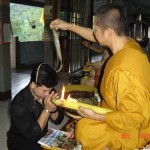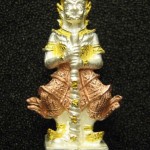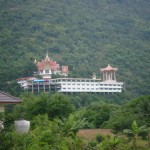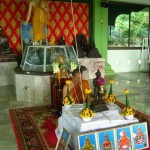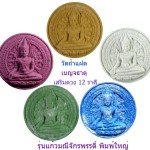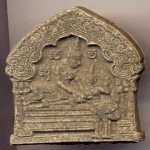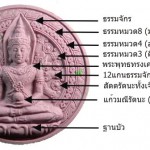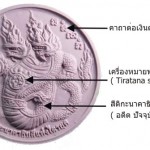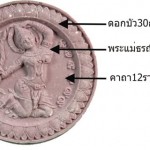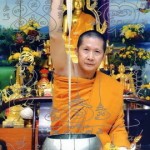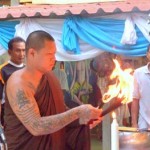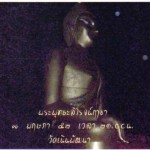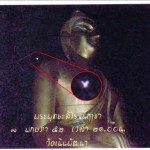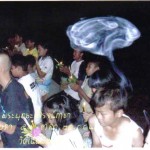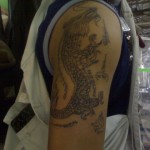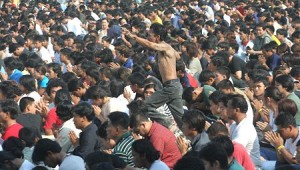
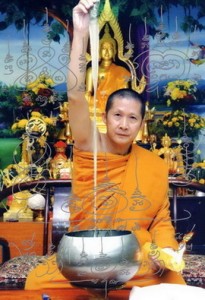
This post includes a Video playlist of the Wai Kroo Ceremony at Wat Tam Faed in Kanjanaburi. The abbot of this temple, Hlwong Por Wachira, is one of the present day’s most famous Masters of Sayasart (Magic). This temple was made famous by Hlwong Por Samrit Kampiro One of Thailands Great Magic Monks, who recieved initiation of the Wicha of Lek Lai, and was able to extract many forms of Lek Lai from where they were concealed withing lava stones, rocks and caves, using his concentrative mind powers and magical Kata to coax them out, whilst requesting permission from the guardian spirits of the Lek Lai.
Lek Lai is a mysterious phenomena and considered a very powerful magical element (Gayasit), which enables the owner/holder/wearer to be invincible to bullets, and other weapons, avoid accidents, illnesses and even attain mystical Psychic powers such as the ability to teleport, become invisible, and even levitate. Lek Lai is one of the cherished posessions of the Ruesi, who use the Gayasit properties of the Lek Lai to enable their psychic abilities and focus their power. A piece of authentic Lek Lai is precious almost beyond measure, sometimes costing between 70 to 100 million Thai baht for one baht weight of the substance (Baht, apart from being a monetary unit, is also a unit of weight measurement – i am not sure but i think one baht is about 225 grams)!
I was lucky enough to recieve one small piece of lek lai which i keep to this day – i recieved it under strange circumstances but choose not to divulge the details of the event. You can see a short documentary video in the clip below the video of Wai Kroo Wat Tam Faed at the bottom of this post.
Apart from the Wicha of Lek Lai, Hlwong Por Samrit was the first ever Master Monk to perform the miracle of “Nam Dta Tian” (candle tears); The ritual is performed by drippiing candle wax into a bowl of prayer water and then pulling the wax out (which, instead of being hardened as is normally the case when dripped into water, is elastic and gelatinous) ina long string, and dropping it onto the head of the devotee in a spiral. This ceremony is called “Korb Mongud Prajao” (laying on of the Lord’s crown). Hlwong Por Samrit left sangkhara and the five khandas (passed away) in 2539 at 20:30 at the age of 72. He was placed in a glass coffin, where his body remains in perfect state without decomposure. But before he passed away, he was able to pass on the Wicha of Nam Dta Tian to his prime disciple Hlwong Por Wachira – who performs this ceremony (miracle?) regularly. This ceremony has become extremely talked about and popular with Thai devotees who travel from all over to come to recieve this blessing. The candle tears which are placed on the head of the devotee is then placed in an amulet press and turned into an amulet, which is then given to the devotee. You can see this ceremony in the second video (Lek Lai) below towards the end of the video.
Watch Video on Wai Kroo Wat tam Faed;
[ad#300×250-self-wrap]
Below Video;Thai Documentary on Lek Lai, Hlwong Por Samret, and Hlwong Por Wachira of Wat Tam Faed temple
Lek Lai has many variations, ranging from rough to smooth in texture, green, gold, black and even rainbow colors are to be found. There are about seven main categories of Lek Lai, which are alleged to posess varying properties as well as priceing. Please be careful if you are interested in obtaining some as an amulet, as (ifyou believe the legends), it is not really possible to buy, rather, you wil recieve it automatically when your baramee (merits) is sufficient. Lek Lai isnt something you can seek out and buy, it coomes to you, and supposedly can perform uncanny feats as in the case of Buddha relics; grow, split, disappear or reappear…
It is said that if a piece of Lek Lai is held by the wrong person, then the Lek Lai will mysteriously vanish. It will aslo appear in just as strange a manner and enter the posession of whom it chooses to stay with.
If you have attained merits and developed psychic power then the Lek lai will be attracted to you like an electromagnet. Some people say that Lek Lai is used to make Nuclear Warheads, and that this is one reason for it’s high price value. I am not so sure about this, it sounds like more of a common folk tale.. but please decide for yourselves on the truth of the matter.
In the below video, a tale is recounted (with photo stills) of a devotee testing a piece of lek Lai using a loaded gun; The devotee lights incense and asks the Devas and angelic intelligences guarding the Lek Lai for permission to admire the power and merit of the Lek Lai by testing it’s power. He then proceeds to shot at it from a distance of about one and a half metres. The first three shots do not sound and no bullet leaves the barrel of the gun – upon attempting to fire a fourth shot, the person appears to fly through the air and lands on the floor as if kicked by a horse – the gun did not fire but the person recoils.
Perhaps this was the guardian of the Lek Lai saying “ok you have seen enough! dont test me too much”???
Watch Video on Lek Lai and LP Samrit of Wat tam Faed;
Links;
http://www.amulet.in.th/forums/view_topic.php?t=1964
www.watthamfad.com
[ad#2movieblogswide]
http://www.alakshmitip.com/?mo=3&art=276970
[ad#amznrishimantrayantrawide]
Extra Goodie; Monk in a boiling Oil Cauldron.
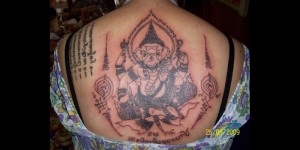
Wai Kroo Samnak Sak Yant Ajarn Hlek Dam
This video shows the Wai Kroo Master Day Ceremony of Ajarn Hlek Dam

Ajarn Hlek Dam Dtechatammo is a Sak yant Master resident at Wat Nern Patanaa temple, Gong Tuul, Hnong Pai, Petchaburn – the ask the Taxi driver to phone and ask for directions in order to find your way to the temple in Ampher Hnong Pai in Petchaburn.
Thailand (0)81-9713514.
In the gallery below the video clip, you can see some Tagrud Amulets made by Ajarn Hlek Dam, and an example of one of his sak yant tattoos, as well as images of Orbs seen in the temple of Wat Nern Patanaa and another phenomena which i started calling “the portal” after my stay in Wat Bang Nom Kho where i also managed to take a multitude of fotographs like these – whenever orbs are present in fotos, there is often (almost always!) a smaller, brighter light in the distance higher up – when i zoomed in the light seemed to be some kind of firefly-like shape. On closer scrutiny and magnification i noticed that the “wing-like” protrusions on the glowing object seemed to be also orblike forms which appeared to be emanating from the bright point of light.
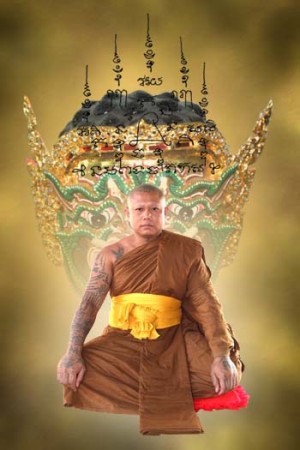
Above; Pra Ajarn Hlek Dam with the Mask of Pra Pirab behind him.
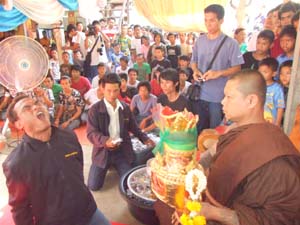
I concluded from this (personal theory/belief/opinion), that the point of light is a portal and the source from which the fainter and larger orbs were emerging from.
In the fotos taken by a Thai devotee at Wad Nern Patanaa, this phenomena seems to be identical. Onlt difference being that thw fotos here are more blurred than the ones i took.
I still have some of those fotos but unfortunately the larger ones were destroyed and am only left with the smaller reduced for web examples. I shall post them here when i have time to look for them in my folders of thousands of pics,so you can compare the phenomena. 😛
Author’s note; Remember that paranormal matters are a matter of personal belief and should be considered with the use of discernment and common sense.
[flagallery gid=4 w=600 h=500 skin=default name=Gallery]
Sak Yant Tattoos by Hlwong Pi Pant (Wat Koh Poon)
[ad#300×250-self-wrap]
A gallery slideshow (scroll down the page to view), of Sak yant by Sak yant dot com’s favourite Master, and my personal Kroo ba Ajarn who was the first Master to be kind enough to initiate me into the mysteries of Sak Yant. It has been a while since i gave Hlwong Pi Pant some exposure, and i feel that he deserves reviewing since so many people have come to enjoy sak yant, i believe that perhaps some people have never had the chance to see what he is made of. LP Pant my good friend and Master is for me the most compassionate of all Masters i have met to this day. And is unequalled still in his expertise in whacking out sak yant with such fluency. His great kindness, friendliness, compassion and jolly disposition is always a refreshing and inspiring experience which leaves you with magical memories of a day in your life well spent with a pure hearted Monk whose simplicity despite of great mastery and power is so difficult to encounter in this day and age.
Long may he be here for us to recieve his blessings. LP Pant is the Wat bang Pra monk whose tattooing is most similar in style and mood to those of the Great Master of all time himself Hlwong Por Phern, who i beieve Hlwong Pi pant to be his most loving disciple and apprentice. LP pant is a piece of living sak yant history and a Legend in his own right!
Pics from 2007 – thanks to professional photographer Martyn Goodacre for use of some of the fotos. martyn is such a talented and gifted fotographer.
please visit www.martyngoodacre.com to admire his work.
[ad#widetextsimoine]
Here is the location of Hlwong Pi Pant at wat Koh Poon temple in Ban Hmor Village just about 12 kms after Chaiyo township in Ang Tong province the blue ballon marks i think the exact spot. you can zoom in and out to print overview and close ups for taxi to get there. Print both the adress in Thai which i have added below and the map in zoom in and zoom out so he can see which motorway to take and you”ll get there fine.
??????????????? ???????????? ???????? ?. ??????? ?.???? ?. ???????
You should get a taxi from the Hmor Chid station at best.. try to haggle for 2000 baht there and back with no meter.It will cost about 2400 with the meter.
View Wat Koh Poon (Hlwong Pi Pant) in a larger map
Buddhism? – Animism? Miracles? Should Monks perform Miracles?
1. Idtibatiharn – such as floating, splitting oneself up into multiple bodies, or changing from many bodies to one body. Walking through mountains, walls etc, Invisibility, diving under the ground,walking on water, using ones hand to wipe out the sun (cause an eclipse), or the moon, or to travel to the Brahma worlds and come back in an instant.
2.Atesanabatiharn:- to read minds, hearts, feelings, or memories of another. These forst two categories were not admonished by the Buddha, because it would not cause people to have faith in Buddhism, due to the fact that those who are not faithful will criticize such miracles saying that one does not need to be enlightened to perform such magics, rather, any person who studies these occult arts can acheive these abilities without having to have become a Buddha. The third category of miracle is known as “Anusasaniyabatiharn. Anusasaniyabatiharn is useful and admonishable for the Bhikkhu to practise, because this kind of miracle is that of the perfect practise of renunciation and purity (the dhamma), which will lead to great goodnees, purity, compassion and wisdom. This practise is the most difficult, selfless and hard to attain miracle of all (becoming an Arahant – enlightened saint). The attainment and practise of anusasaniyabatiharn brings fruit to both the person practising, and thos in his immediate vicinit or who are related to him in some way.Apart from the practise of purity of speech action and thought, in addition the Bhikkhu who acheives the state of beng that is classed as the miracle of anusasaniyabatiharn (batiharn means miracle), should refrain from the following;
The profession of Dierachanawicha (animal or animist magic), make readings from bodly organs, visions, or interpret accidents, predict dreams, or peoples faces or palm reading. To refrain from fire rituals or worship, walking on oil, cast spells, or anything that has blood. Refrain from being a kata master, witch doctor, medicine man, snake. or scorpion charmer,treat rat bites, interpret birdsong, crystal gazing, weapons or people by their appearance. To refrain from making war predictions,or astrological/astronomical predictions, such as meteorites, eclipses etc. Refrain from predicting the weather or the future of common folk. Refraining from making amulets that bring luck or misfortune, love or dissention.Refrain from speaking spells such as katas to silence people’s mouths, or make hands shake or deaf ears. Refraining from blessing homes, clear bad karma, cast out evil spirits, pay devotion and offerings to brahma, the Sun or the Moon. To refrain from ceremonies to bless a site for building a house, or a piece of land. To refrain from making a homosexual become heterosexual or the other way round. Refrain from blowing prayer water, or sprayng it (as we often see with the wooden brush) – to refrain from preparing medicines and ointments for curing headaches, animal bites, perform any kind of cutting or piercing of the skin, or to take care of a young child, give medicines or to clean wounds. Blood is particularly to be avoided (sak yant???).
The Bhikkhu who is ordained with the dedication to practise “Brahmacarya” (pure life heart and mind),aims for the liberation from “Kilesa” (attachment to selfish pleasures and craving), ceremonial dogmatic rites that are occult or astrological in nature. This kind of Bhikkhu is seen to be demonstrating the Miracle of anusasaniyabatiharn ceaselessly 24 hours each day.This is how Buddha explained the performing of Miracles to The Brahmin Gewata (son of the mayor of the town) when getawa visited in the Mango grove of the wealthy mogul Bavarika to ask for miracles to be demonstrated.
“You see Gewata, a Bhikkhu whose precepts are so pure as these, will never have to confront any dangers in any time and place and shall be safe, because of his “Sila” (precepts of purity). He is comparable to a King who has conquered all his Royal enemies already. This kind of Bhikkhu will have inner peace and happiness and have perfection as his protection.”
Having said this, when we study the Tripitaka (Buddhist Canon) in detail, we can find passages that refer to Budddha admitting that some Bhikkhus did perform the first two kinds of Miracles which the Buddha did not approve of; Idtibatiharn and Atesanabatiharn. But Lord Buddha did not see well of it, nor did he support it in any way at all, because it is the same kind of behaviour that illusionists and circus magicians can also appear to perform (as in the “Indian Rope trick”).Buddha explained that the stron point and base foundation fo the practise and behaviour of an ordained member of the Sangha, is the practise of perfecting one’s bodily behaviour (actions) and speech and mind to let it become soft and gentle and light. Not to practise things which may cause common folk to come and pay devotion, respects and make offerings to you for.In the Buddha’s time, there were many Bhikkhus running around showing off their powers, and this is how Buddha came to have to mae a statement on the topic.He is purported to have commented that; “There are many Brahmin preists and magicmen who make a profession out of Dierachanawicha” (dierachana means “animal” and “Wicha” means Arts or Craft/Knowledge – meaning Animistic magic). “All they desire is to show off with Miracles. But the Disciples of the Buddha should have the profession (not meaning job, – think of the word “to profess”, meaning to vow) of developing their inner and outer purity through the practise of Dharma! Not to do like the brahmins.” The Brahmins would show powers in order to the commoners in order to get them to come and make rich offerings and pay devotion honor and respect, which is one fo the “Kilesa” that a Bhikkhu should be refraining from and cutting the roots of..The demonstration of the miracle of Anusasaniyabatiharn was suported and wished for by Buddha, and said to bring limitless blessings and fruits to those who practise it and those in their vicinity.
I also once saw a video from wat tam faed temple in Kanjanaburi, which made a showshowing how the abbot pulled the “mid Hmor” (magic knife) out of the “Nam Monthr” (prayer water) and rolled some kind of “ectoplasmic goo” around it, which seemed to come from the “khee tian” (candle wax) which he had been letting drop into the bowl as he chanted. The “goo” was then wound around the devotee’s head, and subsequently given to an assistant, who then would take it to the amulet press and let the devotee press it into an amulet, which he was then allowed to keep. Unfortunately for Wat Tam Faed, i saw this video and remembered making nylon using acetone and some other stuff in chemistry class, and remember winding the same identical looking “cosmic goo” around a glass rod and pulling out of the clear liquid in exactly the same manner. I don’t believe that temple, have also foned the place and tried to talk to the Abbot asking to visit, upon which he hung up. Please be wary of charlatans. Maybe i am wrong, but those pressed amulets didn’t half look lke acrylic/nylon – they were even transparent. If anyone goes and gets one take it to be tested at a chemist or some plastic expert. I myself hope to get the chance to visit and obtain one to decipher if this is real magic or not I have a few of the Wat pramote amulets if anyone wishes to get one, pm me or email me |
This shows a scene at Wat Pramote temple, which currently advertizes its’ latest edition of amulets as being able to protect the wearer from being burnt by acid, and devotees are freely invited to go to the tmeple to test them out for themselves. A lay devotee from the temple is there with bottles of acid for you to see how he pours the acid on clothing, which then bursts into flames and disintegrates in smoke. He then gets you to hold the amulet and stretch your hand out whilst he pours some acid on the hand that doesnt have the amulets. Although this may be authentic, i tend to believe that they are using “grod Klua” (salts acid) which i often have used to solder tattoo needles with using my bare hands..This acid will melt plastic and burn cloth, but not skin, glass or metal. Chemistry has some strange things, and one can easily fool people who have no knowledge of chemical properties. I have some of this amulet actually so maybe i will risk a real “Kool Aid acid test (lol) – and hope it doesn’t turn ito a “band aid” acid test 9meaning it didnt work and i lost the skin off my finger). Ill post and let you know if i end up daring to do it. Im a little dubious as i still remember my fear as Ajarn Noo took the Carpet cutter and sawed my arm after having shaved my leg with it first to prove it’s sharpness. That left me with little desire to test the protective powers of amulets. |
